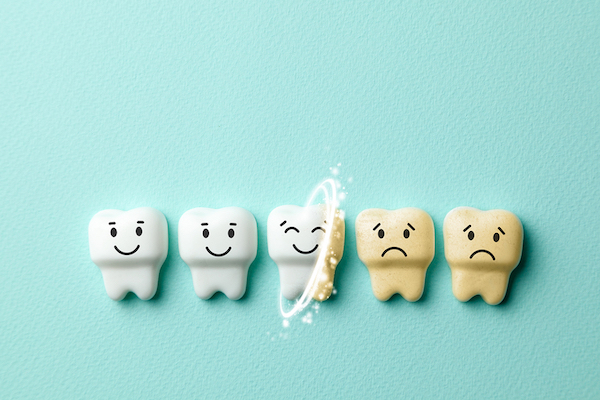Patients ask how to get their teeth whiter, more than almost any other dental procedure, say dentists.
Most of us may worry about stains from coffee, wine or even tobacco use. But then there’s a smaller subset with an even bigger problem than just overall yellow teeth: A single tooth—right in your smile line—that’s clearly a different color from the rest.
Dentists call this “the single dark tooth,” with colors ranging from yellow to orange to brown. “When all your teeth are yellow, that might not bother you because not everyone is going to be super conscious that your teeth aren’t white,” said the Dental College of Georgia’s Dr. Mario Romero, who focuses on esthetic and restorative dentistry. “But if you have a darker tooth right in the front, everyone may notice.”
“I Have a Dark Tooth—But Why?”
Over time, food, drink and smoking can stain teeth. But a single dark tooth is caused by very specific reasons.
“The number one reason is a root canal,” Romero said.
During a root canal, a dentist removes the nerve from a tooth and replaces it with an inert material. Even with a perfect root canal, sometimes that material can be too close to the crown of the tooth—the part we see when we smile. When that happens, the tooth can appear darker. Or, bleeding inside the tooth or dark pigments from any nerve tissue left inside can play a role.
Another reason is trauma to a tooth, say if you get hit in the face while playing sports. To protect itself, a tooth might start producing more dentin, which is the layer just underneath your enamel, or the white part of your tooth. Thick, heavy dentin can darken; that color shows through your enamel since it is translucent.
Then there’s tooth decay. When sticky plaque forms, fed by the sugar in our diets, it can destroy tooth enamel. Then cavities can form—but teeth can also get darker.
Not Just Whitening
Patients might ask about how to whiten a single dark tooth. “But the number-one thing to do is to find out the causing factor and eliminate it,” said Romero.
For a root canal, that would mean going back in and removing the extra inert material. With tooth decay, a thorough cleaning, an examination and treatment of any cavities, and education on how to prevent tooth decay—such as twice-daily brushing with a fluoride toothpaste, daily flossing and fewer sugary treats in the diet—are needed.
After that, tooth whitening can finally happen.
For a single dark tooth—and for other whitening—Romero uses a bleaching agent, 10 percent carbamide peroxide. For just one tooth, the agent is applied in a specially designed tray that’s called the “single dark tooth bleaching tray,” with a single pocket that covers the affected tooth and windows for the neighboring teeth.
Conveniently, patients can do the treatment at home, which evidence says is just as effective and even safer than in-office bleaching. Research has found that other products with higher concentrations or with hydrogen peroxide could cause burns, gum damage and other issues. “In fact, hydrogen peroxide alters the topography of the enamel, the mineral that covers the tooth,” said Romero. “In studies, it took up to 90 days of using fluoride for teeth to recover.”
Also, Romero said, only carbamide whitening products with a 10 percent concentration have a seal of acceptance from the American Dental Association. “The most important thing is to be safe and to never do any irreversible damage,” he said, since damaged gum tissue could lead to receding gums, irritation and sensitive teeth.
Most patients choose to do the treatment at night while sleeping, since the agent is effective for up to six hours. This is also the technique advised by dentists; in fact, the first dentist to publish research on the benefits of night guard bleaching was Dr. Van Haywood at the Dental College of Georgia. Patients should wear the night guard for seven to 15 days to ensure a dark tooth matches remaining teeth.
Then, if patients want all of their teeth to be whiter, they can switch to a regular tray. During this step, patients should see their dentist every five to seven days to make sure teeth are getting evenly white, but not too white, since the dark tooth will be more resistant to further whitening than the rest of the teeth.
This—and other reasons—is why professional help to whiten teeth is so important. “People want to have beautiful white teeth, and a lot of products—especially over-the-counter products, promise that, but it never happens,” Romero said. “That’s why there is dentistry and dentistry research. If you have an issue like a single dark tooth and really want to make a difference in your smile, get professional help from a dentist.”





